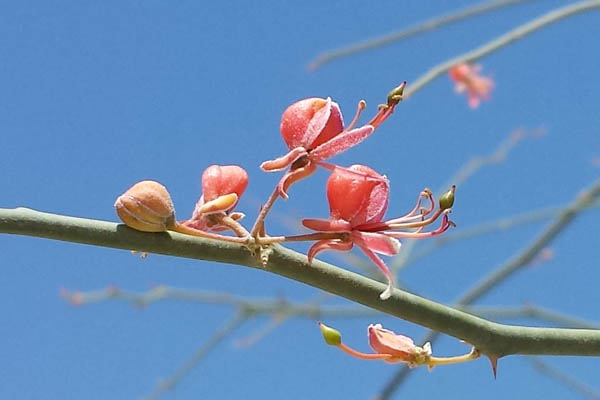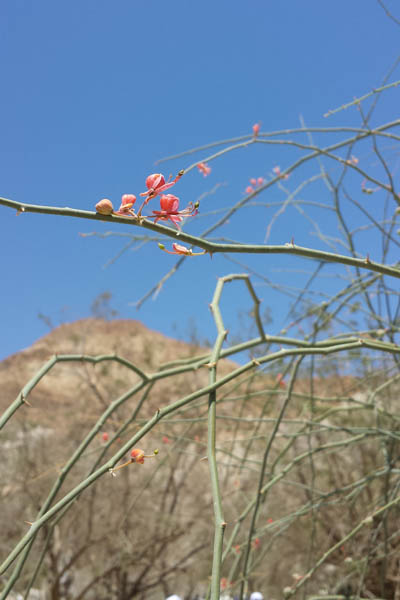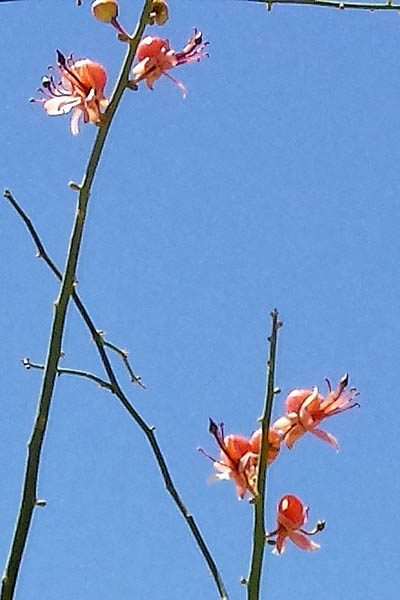Caper berry, Caper plant, Wild caper,
Hebrew: צלף רותמי, Arabic: حنبوق , تندب , سوداد
| Scientific name: | Capparis decidua (Forssk.) Edgew. | |
| Synonym name: | Capparis aphylla Roth | |
| Common name: | Caper berry, Caper plant, Wild caper | |
| Hebrew name: | צלף רותמי | |
| Arabic name: | حنبوق , تندب , سوداد | |
| Family: | Capparaceae, Caper family, צלפיים |

|
| Life form: | Many-branched shrub or small tree | |
| Stems: | Leafless green crooked spiny branches slender, smooth, terete and spinous; mature branches are leafless as leaves are present only on young shoots; small, sharp, straight, light brown spines occur in pair at each node of twig; most twigs and branches are glossy and dark green in colour, but with age, bark develops which is whitish gray | |
| Leaves: | On young branches, caduceus, linear, 1-2 cm long, apex short, stiff, pale mucro like pickle, petioles very short, stipular thorns long, sharp, straight orange yellow | |
| Inflorescence: | Corymb with many flowers arising from old branches or from short lateral shoots, in the axils of the spines | |
| Flowers: | Red or pink, rarely yellow; Petals: Pink, red-veined, narrow-oblong; Gynophore about 12 mm long; Androecium 8 stamens, inserted at the base of gynophores; Pedicel lender and about 12 mm in length | |
| Fruits / pods: | Small, globular, glabrous, fleshy berry, beaked at the apex, resembling a cherry in shape and size; fresh berries are green, which turn pink on ripening and blackish on drying | |
| Flowering Period: | May, June, July, August, September, October | |
| Habitat: | Desert | |
| Distribution: | Judean desert, Dead Sea valley, Negev hills | |
| Chorotype: | Sudanian | |
| Summer shedding: | Perennating |

Derivation of the botanical name: Capparis (latin), borrowed from Greek kapparis [κάππαρις], whose origin is unknown but probably West or Central Asia (Alkabara, kabar). Another theory links kapparis to the name of the island Cyprus (Kypros [Κύπρος]), where capers grow abundantly. Arabic kafara, to be hairy, villous. decidua, deciduus, "falling off at maturity" or "tending to fall off." aphylla, without leaves. The Hebrew name: צלף, tzalaf, zalaph, which in the Bible is a proper name (Nehemia 3:30). The caper's fruit, the evyonah, is mentioned in Ecclesiastes 12:5 as a symbol of shortness of man's life, because very soon after it blossoms, the fruit scatters its seeds and the plant withers; "The almond-tree shall blossom… and the caperberry shall fail; Because man goeth to his long home…."

|